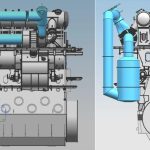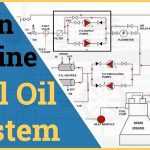Starting of generator engine
Starting of an engine from “stop” state is something which needs to be done with care, especially if the interval of starting is sufficiently long. The following is a checklist of all the checks which ideally need to be carried out before starting the generator. In actual practice sometimes the engineers might take some of these for granted and skip, but it is advisable not to indulge in such a practice. Infact these checks are generic for any four stroke engine starting process
1. Check the turbocharger sump oil level, governor, alternator, forward and aft lube oil levels, and diesel oil level in service tank
2. Open the indicator cock
3. Prime the lube oil to all parts by hand pump or by motor driven priming pump
4. Ensure that all jacket cooler valves, lube oil cooler valves, air cooler valves should be in open position
5. With use of the Turning bar turn the fly wheel and check for any resistance on the bottom end bearing and check any water / fuel coming out through indicator cocks
6. While turning engine, check all visible lube oil points are lubricated
7. Remove the turning bar from fly wheel and put in the place
8. Drain the auxiliary air bottle
9. Blow through engine (ie: by turning engine with air). In order to ensure that no water is inside combustion chamber if it is present it may cause water hammering
10. Close the indicator cocks and pull lever from stop to start
11. When the needle in RPM indicator deflects to some value of (0-25 rpm) put the lever in run condition
12. The engine will run on fuel oil once the generator picks up the rated speed
13. Put generator on load by closing air circuit breaker
14. For checking the alternator fore and aft bearing lube oil level by opening oil plug in the alternator and the ring bearing while rotating splash lube oil from the sump can be seen
15. In order to synchronize the incoming generator with running generator syncroscope method/dark lamp method is used
Starting of generator

Checks to be made while running
Once the generator has actually started to run, there are several checks which must be performed before it is left on its own to continue running. These checks pertain to verifying various parameters related to lube oil levels, temperatures and so forth. Given below is a brief checklist related to the same.
Lube oil checks
1. Sump lube oil level
2. Governor lube oil level
3. Rocker arm lube oil level
4. Alternator forward and aft bearing lube oil level
5. Lube oil in turbine & blower side of turbo charger
Temperature checks
6. Exhaust gas temperature
7. Turbocharger (inlet-outlet) temperature
8. Booster air inlet temperature
Cooler temperatures
9. Cooling sea water (inlet – out let) temperature in cooler
10. Jacket cooling water (inlet – outlet) temperature
11. Air cooler (inlet -outlet) temperature
12.
Safety devices
Once the above mentioned parameters have been checked and found within normal range, it is safe to continue running the generator. Yet a fault can develop even at a later stage, so for this very purpose various trips and alarms are situated on the generators. An alarm gives the signal of an impeding danger and requires quick action while a trip actually trips the generator immediately because of the nature of the fault.
The various trips and alarms are mentioned as follows
13. Alternator bearing low oil level alarm & trip
14. Alternator bearing high temperature lube oil alarm &trip
15. Low sump oil level alarm and trip
16. Lube low oil pressure alarm and trip
17. Reverse current trip
18. Over speed trip
19. Over load trip
20. High and low frequency trip
21. Jacket cooling water low pressure alarm


